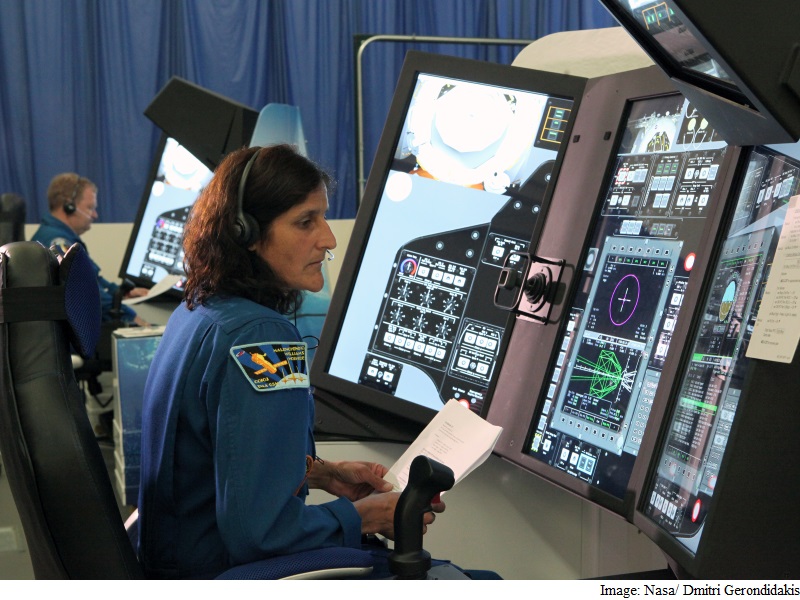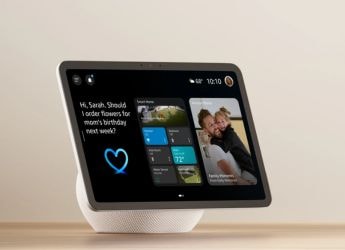- Home
- Science
- Science News
- Nasa Astronauts Prepare for Flight on Commercial Spacecraft
Nasa Astronauts Prepare for Flight on Commercial Spacecraft

Five years after the last Nasa astronauts flew from Cape Canaveral, Florida, to the International Space Station, a new group is preparing for a trip, this time on a private spacecraft.
On Tuesday, veteran astronauts Eric Boe and Sunita Williams used touch-screen simulators to practice docking Boeing Co.'s CST-100 Starliner spacecraft with the space station during a training session near Lambert-St. Louis International Airport. The simulator, called the Crew Part-Task Trainer, helps prepare astronauts and flight controllers for missions, flight conditions and situations including the rendezvous and docking with the space station.
"This is the next really exciting chapter for our country and our space program," Williams said. "It refocuses on what I think is really important - planning for the next generations and thinking of their future."
The United States hasn't seen a manned launch since Atlantis blasted off on the final space shuttle mission in 2011. Nasa currently is hiring out its supply runs and paying Russia to ferry astronauts to the space station.
The space agency wants to continue outsourcing those tasks so it can focus on getting astronauts out of low-Earth orbit and on to Mars and other destinations. Nasa is developing the Orion spacecraft and Space Launch System for those longer journeys and has contracted with Boeing and another US company, SpaceX, to transport astronauts to the space station.
"If you think of Mars as the pinnacle of Everest (and) low-Earth orbit as base camp, the commercial companies that service low-Earth orbit are the sherpas that take things back and forth," said Chris Ferguson, deputy program manager and director of crew and mission operations for Boeing's commercial crew program. "It enables Nasa to go and perform their exploration mission."
The cost for a ride on a private, American-operated spacecraft will be $58 million (roughly Rs. 385 crores), cheaper than Russia's $76 million per ride, according to Nasa.
Boeing's role in space exploration began in the 1960s. The McDonnell Aircraft Corporation, which later merged with McDonnell Douglas before its merger with Boeing - developed the Mercury and Gemini space capsules.
In 2014, Nasa awarded Boeing up to $4.2 billion (roughly Rs. 27,905 crores) to develop the Starliner, its launch vehicle and mission operations and ground systems. The contracts with Boeing and SpaceX, which is developing a next-generation crew capsule, total $6.8 billion (roughly Rs. 45,179 crores) and require at least one test flight with at least one Nasa astronaut on board. Boeing's contract includes up to six missions to the space station.
Boeing's Defense, Space & Security division is building several training devices in St. Louis, including the Crew Part-Task Trainer and a full-scale mission simulator that will run astronauts through dress rehearsals, from problems during launch to the recovery of the spacecraft. The simulator and other training devices will be delivered to the Johnson Space Center in Houston over the next year.
Boeing and SpaceX are aiming for test flights to the space station by the end of 2017.
Catch the latest from the Consumer Electronics Show on Gadgets 360, at our CES 2026 hub.
Related Stories
- Samsung Galaxy Unpacked 2025
- ChatGPT
- Redmi Note 14 Pro+
- iPhone 16
- Apple Vision Pro
- Oneplus 12
- OnePlus Nord CE 3 Lite 5G
- iPhone 13
- Xiaomi 14 Pro
- Oppo Find N3
- Tecno Spark Go (2023)
- Realme V30
- Best Phones Under 25000
- Samsung Galaxy S24 Series
- Cryptocurrency
- iQoo 12
- Samsung Galaxy S24 Ultra
- Giottus
- Samsung Galaxy Z Flip 5
- Apple 'Scary Fast'
- Housefull 5
- GoPro Hero 12 Black Review
- Invincible Season 2
- JioGlass
- HD Ready TV
- Laptop Under 50000
- Smartwatch Under 10000
- Latest Mobile Phones
- Compare Phones
- Honor Magic 8 RSR Porsche Design
- Honor Magic 8 Pro Air
- Infinix Note Edge
- Lava Blaze Duo 3
- Tecno Spark Go 3
- iQOO Z11 Turbo
- OPPO A6c
- Samsung Galaxy A07 5G
- Lenovo Yoga Slim 7x (2025)
- Lenovo Yoga Slim 7a
- Lenovo Idea Tab Plus
- Realme Pad 3
- Moto Watch
- Garmin Quatix 8 Pro
- Haier H5E Series
- Acerpure Nitro Z Series 100-inch QLED TV
- Asus ROG Ally
- Nintendo Switch Lite
- Haier 1.6 Ton 5 Star Inverter Split AC (HSU19G-MZAID5BN-INV)
- Haier 1.6 Ton 5 Star Inverter Split AC (HSU19G-MZAIM5BN-INV)







![[Sponsored] Haier C90 OLED TV | Dolby Vision IQ, 144Hz OLED and Google TV in Action](https://www.gadgets360.com/static/mobile/images/spacer.png)








